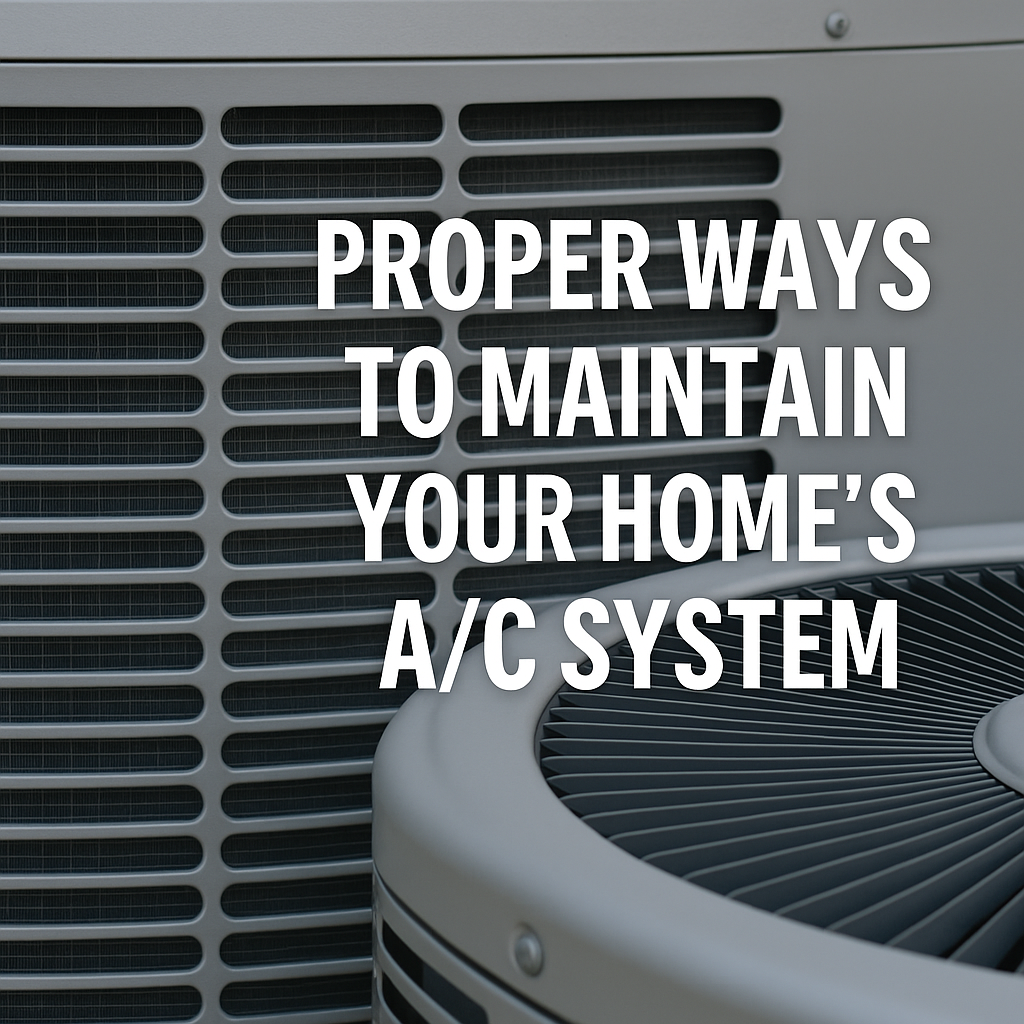An air conditioning system is one of the most critical components of home comfort—especially during the sweltering months of summer. Like any mechanical system, it requires consistent care to perform efficiently and reliably. Poor maintenance not only leads to breakdowns and costly repairs but can also drive up your energy bills and shorten the system’s lifespan.
To avoid these pitfalls, here’s a detailed, step-by-step guide on the proper ways to maintain your home’s A/C system.
1. Change or Clean Air Filters Regularly
Why It Matters:
Air filters trap dust, pollen, pet dander, and other airborne particles. A clogged or dirty filter restricts airflow, making your system work harder and reducing indoor air quality.
Best Practice:
-
Replace disposable filters every 30–90 days, depending on usage and household factors (pets, allergies, etc.).
-
Clean reusable filters monthly.
-
Consider upgrading to a HEPA or electrostatic filter for improved air purification.
2. Inspect and Clean the Condenser Coils
Why It Matters:
The outdoor condenser unit releases the heat removed from inside your home. Over time, dirt, debris, and leaves can clog the fins, reducing efficiency and forcing the compressor to overwork.
Best Practice:
-
Turn off power to the unit before cleaning.
-
Use a soft brush or vacuum to remove surface debris.
-
Gently rinse the coils with a garden hose (never use a pressure washer).
-
Trim back vegetation to maintain at least 2 feet of clearance around the unit.
3. Keep the Evaporator Coils Clean
Why It Matters:
Located inside the indoor unit, the evaporator coils absorb heat. Dust buildup on these coils insulates them and reduces their ability to cool air.
Best Practice:
-
Have a technician inspect and clean the coils annually.
-
If accessible, gently wipe the coils using a no-rinse coil cleaner available at most hardware stores.
4. Check and Clear the Condensate Drain Line
Why It Matters:
As your A/C cools your home, it produces condensation that drains through a line. If this line becomes clogged, it can lead to water leaks, mold growth, and damage to drywall or flooring.
Best Practice:
-
Flush the drain line with a mixture of water and white vinegar every 2–3 months.
-
Use a wet/dry vacuum on the outdoor drain pipe to remove clogs.
-
Install a float switch to automatically shut off the system if the drain backs up.
5. Inspect Ductwork for Leaks or Blockages
Why It Matters:
Leaky or poorly insulated ducts can waste up to 30% of your A/C’s energy output, leading to higher bills and uneven cooling.
Best Practice:
-
Visually inspect accessible ductwork for holes, disconnected joints, or insulation gaps.
-
Use mastic sealant or foil tape (never duct tape) to repair minor leaks.
-
Hire a professional for duct pressure testing and sealing if you suspect significant energy loss.
6. Check Thermostat Settings and Calibrate if Needed
Why It Matters:
A properly working thermostat ensures your A/C operates at optimal levels without overcooling or short cycling.
Best Practice:
-
Upgrade to a programmable or smart thermostat to automate temperature settings and save on energy.
-
Test the thermostat by comparing room temperature to the thermostat’s reading.
-
Replace batteries at least once a year if not hardwired.
7. Lubricate Moving Parts
Why It Matters:
Friction from dry or worn parts, especially in older systems, can cause premature motor failure and reduce efficiency.
Best Practice:
-
Schedule annual maintenance with an HVAC technician to lubricate motors, fans, and bearings.
-
Modern systems may have sealed motors that don’t require lubrication—but always confirm with your manufacturer’s guidelines.
8. Check Refrigerant Levels
Why It Matters:
Low refrigerant levels indicate a leak, which can cause your A/C to underperform or damage the compressor.
Best Practice:
-
Only licensed HVAC professionals can check, repair, and recharge refrigerant levels legally and safely.
-
Have your technician inspect for leaks during annual servicing.
9. Schedule Annual Professional Maintenance
Why It Matters:
Preventive maintenance helps identify small issues before they become expensive repairs and ensures your A/C runs at peak efficiency.
Best Practice:
-
Book an annual inspection before peak summer months (spring is ideal).
-
Ensure the service includes a full inspection, coil cleaning, drain line flushing, refrigerant check, and airflow testing.
10. Monitor System Performance
Why It Matters:
Understanding how your system normally functions helps you detect early signs of trouble such as:
-
Unusual noises or odors
-
Inconsistent cooling
-
Higher than usual energy bills
Best Practice:
-
Keep a log of your system’s operation, including filter changes, repairs, and energy usage.
-
Don’t ignore warning signs—early intervention prevents bigger problems.
Conclusion
Properly maintaining your home’s air conditioning system is not just about comfort—it’s about protecting your investment, saving money, and ensuring a healthy living environment. A combination of regular DIY upkeep and professional servicing will keep your A/C running efficiently year-round, extend its life, and keep your energy costs under control.
Remember: A well-maintained A/C system doesn’t just cool better—it lasts longer.
